Home » Blog » Are You An Architecture Student? » Guidance Through Empathy: Are You an Architecture Student? (ȹ)

Havva Alkan Bala
Prof. Dr.
SHARE
Abstract
Architecture deals with not only visible concrete values but also invisible abstract concepts. This nature of architecture liberates its education in the context of its tools, methods and relationships and renders it unique. It is observed that high school students in Turkey, who go through a multiple-choice based education system, have difficulty in thinking through visual images and imagining. When the basic and widespread problems are presented through empathy two groups of suggestions can be made. The first group of suggestions that provide solutions to the problems are about the mental transformation. The second group is behavioral and performative activities. It should be emphasized to the prospective architects during their undergraduate education that the school is not the place where ways are found, but rather where they are taught how to find them. The question of how to prepare architectural education for the digital age is also important.
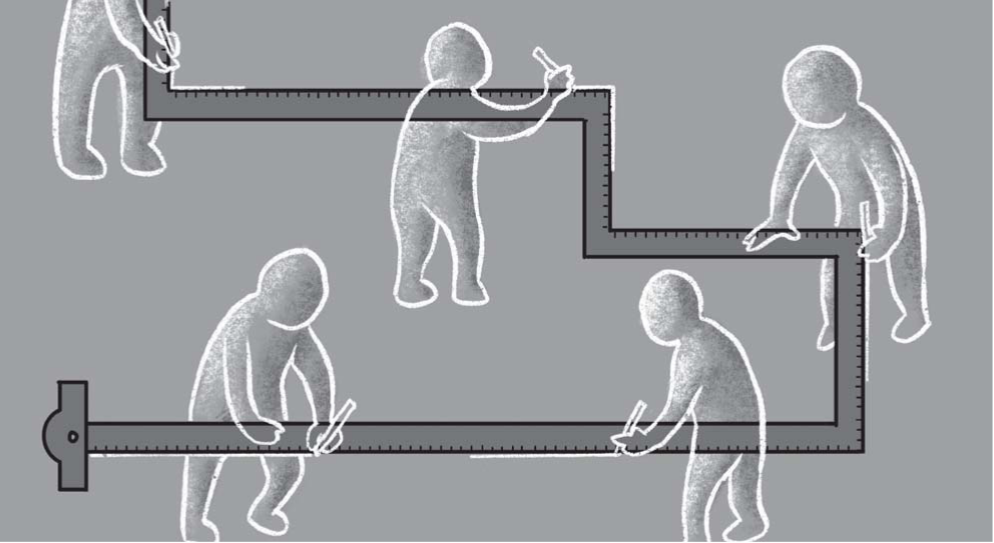
1. Introduction
Architecture deals with not only visible concrete values but also invisible abstract concepts. Architecture is an art. However, it has technical, economical, legal, political and functional dimensions. As an artist, a painter can draw a square wheel, but as an artist, an architect’s wheel should be able to turn even if it is square. Architecture offers molded forms and spaces that provide pleasure, but at the same time incorporates and integrates mental constructs. This nature of architecture liberates its education in the context of its tools, methods and relationships and renders it unique. Architecture is an eternal process of education so there is no ideal formula. Efforts aimed at formulating architectural education are meaningless in the face of branched, multi-layered and fuzzy ontology of architec- ture. The challenging and stressful nature of the architectural education, the demanding characteristics of the training program structured with theoretical and practical content brings unique problems and difficulties for all actors involved in education (Erman, 2000). Problems and expectations of students should be determined in order to establish a healthy learning-teaching environment. Empathy avast password activation code is to understand and internalize the motivation in someone else’s situation or behavior. This study aims to reveal through empathy the fundamental and common problems and guiding ideas that could serve as solutions to those problems. Developing a common language through empathy will increase fluidity between the learner and teacher. In this study, defining architecture students as owls and coding them with the symbol (ȹ) was preferred to underline the concept of empathy.
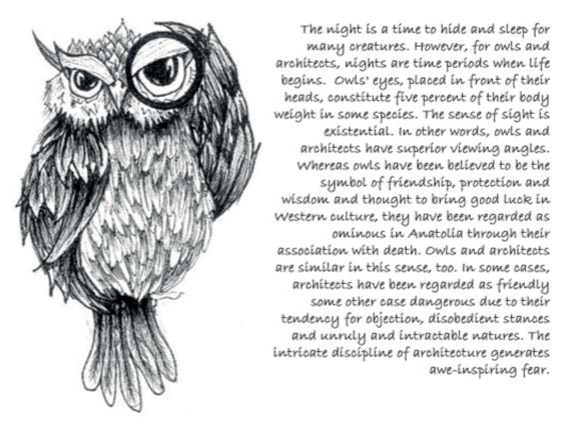
2. Focus of Research
The main focus of this study is to understand through empathy the problems which ȹ encounter in Turkey and to serve as a guide for basic mental, behavioral and pragmatic ideas.
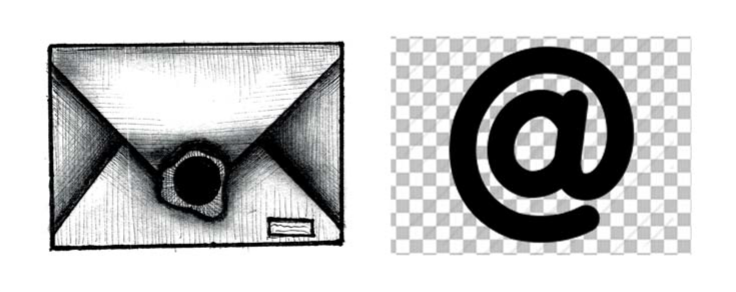
2.1. Spirit of the age; nomads teach the natives
Today’s ȹ are digital natives because they have been using the internet since infancy. They perceive technology as a natural standard of living. On the other hand, those who teach them are digital immigrants. Generation X, now in their 40s and 50s have witnessed many of the technological inventions and have learned to use at the same time. Generation Y, in their 20-30 years old nowadays, has internalized the digitalized world not only with its technological dimensions but also with its social dynamics. Generation Z, who was born after the 2000’s, has the ability to handle different issues simultaneously and consumes ideas, objects and relationships faster than generation X-Y (Csobanka, 2016). Generation Z grasps technology quickly, performs their activity within a short time, uses the latest communication tools and prefers to maintain relations with their friends through social media. Generation Z chooses the path of digital learning, has fun digitally, and lives a creative and innovative lifestyle with less productivity, but more consumption. Therefore, the state of the experienced X-Y generation instructor who knows a lot, dictates, shows and teaches the right way to the little-knowing generation Z student does not work anymore. Unfortunately, generation X and Y lag behind the ȹ in terms of adaptation to technology.
2.2. Distorted Perception of Definition
Defining architecture with concreate values and criteria such as money, prestige and social status, which capitalism glorifies, and choosing this profession on the basis of those criteria constitute a problem. Moreover, glorification of the definitions suggested by popular culture in the media and social media through capitalistic values causes ȹ to begin the school of architecture with a distorted perception. It is not adequately recognized that architecture is an occupation of pleasure, humanism and aesthetics that generates a life scenario. Indeed, there are reductionist approaches that associate architecture with the ability to paint pictures or see it simply as constructing buildings. Architecture is the profession of asking questions and questioning. Architecture is first and foremost about our ability to find answers that no one else can see and in fact to ask new questions in response to those answers. Therefore, questions are asked in architectural education not to seek answers but to seek ways to generate new questions. Questions are a means of gaining new awareness rather than finding the answers.

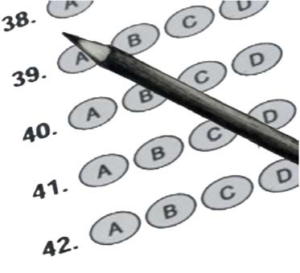
2.2. Distorted Perception of Definition
It is observed that high school students in Turkey, who go through a multiple-choice based education system, have difficulty in thinking through visual images and imagining. During their adolescence, they constantly did tests, memorized texts, were programmed to respond with similar answers to certain types of questions. They are evaluated using tests that include clear questions from a maximum of four or five options and with only one correct answer (Figure 4). When they marked one of the given choices without even understanding the question, they now had an answer. This mindset has encompassed the mental states and ways of thinking of ȹ.
2.4. Concrete to Abstract Thinking Paradigm
The most challenging issue in architectural education is perhaps the ability to switch from precision to contextual and from concrete to abstract thinking paradigm. A thinking method based on patterns develops in multiple-choice curriculum, but in architectural education, one should be prepared to give open-ended, flexible and multi-dimensional answers by being sensitive to the differences in perceptual paradigms.
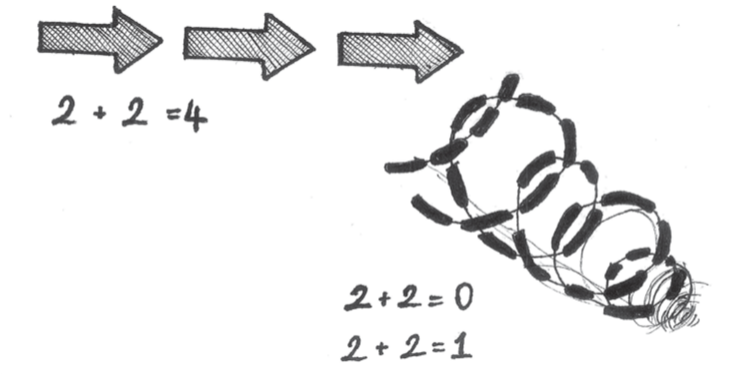
The obvious, linear and sequential perceptual paradigm of 2 + 2 = 4 should be gradually replaced with a spiral, fluid and variable flexibility that evolves into the multiplicity of 2 + 2 = 0 (mod 2) and 2 + 2 = 1 (mod 3). The mind, accustomed to thinking with a clarity of 2 + 2 = 4, must evolve to comprehend with contextual facts. Our way of thinking must acquire perceptual flexibility by being predisposed to the probability. It is difficult for ȹ to leave aside the piecemeal, singular, rigid and constrained dogmatic approaches and learn to reach a holistic, inclusive, spiral, fluid and flexible way of thinking.
2.5. Problems Stemming from the City, Institution and Instructors;
Architectural education cannot be confined to the border of university. The life in the city itself is a kind of education. The city trains the designer with its managers, employers, architects, faculty members. If the city cannot cater to the prospective architects with its lifestyle and culture, this is a problem for ȹ. Schools offering architectural education have many dilemmas stemming from the institution’s facilities, educational programs, administrators and academic staff. The absence of a studio environment results in failure to comprehend three-dimensional design thinking capacity which is also influenced by the space where it is produced. An even more unfavorable factor than insufficient physical conditions, spatial problems, lack of technological tools and equipment and their implications on architectural programs is the absence of a motivating and exciting environment.

2.6. The Impact of the Turkish Family Life
One of the major problems faced by ȹ in Turkey concerns the family codes and widespread interventions in family relations. Here, one encounters difficulties associated with delayed adulthood caused by cultural codes in contrast with universal criteria. Individuals receiving university education are put under pressure by their parents’ expectations. The high cost of architectural education, working for long hours uninterruptedly, tools that have not been encountered in the previous education periods such as model making, technical trip, and staying at school at night worry some families. Seeing their parents’ worried state in turn makes ȹ more anxious.
3. Method
In this study, the basic research problem and the proposed solutions to this problem are presented with the idiographic method. The epistemological assumption seeks the causal relationships and regularities between the parts that constitute the whole in architectural education. Hypotheses created according to the current state of things can be confirmed or falsified by empirical research programs suitable for them (Burrel and Morgan, 1979). The present study handled and examined the generalization and validation principles in epistemological dimensions. Collection of data and analysis and interpretation of data involve observations, memoirs, case studies and experience transfers covering a period of 24 years obtained from different architecture schools. There are observed and latent variables depending on the observability of the variables. In order for the observations to be safe, valid and gain scientific merit, individual experiences should be recorded and systematized and general principles related to these should be discovered with experience, consensus and expert opinion.
4. Findings and Discussion
According to Rogers et al. (2014), the first rule to form an interaction through empathy is to understand. The second rule is to prepare the environment according to what is understood. In order to empathize with ȹ and provide a healthy learning experience, it is important to know the problems they face. Accordingly, suggestions were made concerning the problems stated above, which are commonly observed in architecture schools in Turkey
4.1. Meta – Thinking
It is important to acquire the skill of “thinking about thinking”. The questioning mind, called “meta-thinking, will lead to constant dialogue, review, critique and re-questioning about our thoughts, and generate creative solutions in architectural thought. Higher order thinking skills will bring one closer to abstract rather than concrete, asymmetry rather than symmetry, and simplicity rather than complexity. Designers should return to the very origin, the most basic, the essence. Nature is the best teacher and inspirational. Higher awareness will give us the ability to think outside the box.
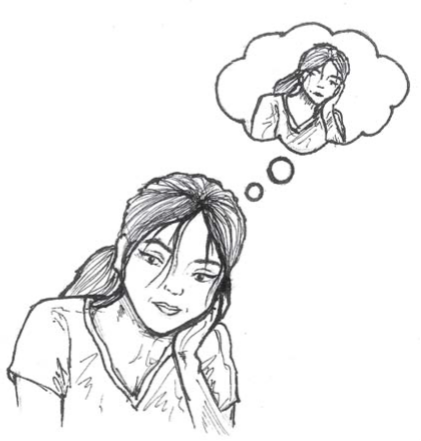
4.2. Learning from Encounters
The city one lives in should be considered as an architectural laboratory and seen as an extremely important opportunity. Travel is so vital to create encounters.ȹ can be travelers in the city they live in with the urban idleness called flaneur (Benjamin 1999).ȹ is a person who generates ideas with the impres sions of the environment while walking around on foot and can make new discoveries with the spirit of a traveler.
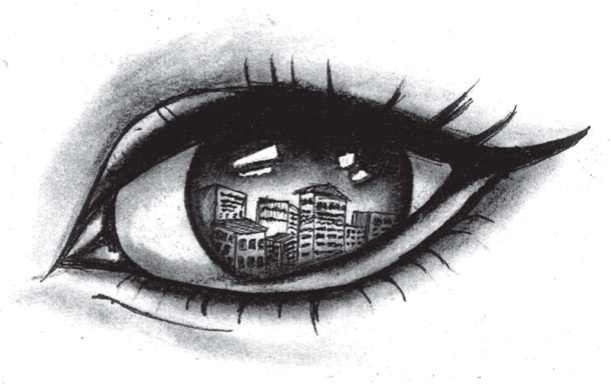
4.3. Studio Culture and Peer Learning
The design studio is a collective environment designed to learn the application of architectural education, with its own truths, materials, tools and language (Schön 1985). In the studio, instructors often do not say clearly what they want. This is the nature of architectural education, because truths and ways must be discovered in the process of architectural design. Exercises done in the studio are not expected to be perfect. What is important here is to learn to develop a design method. With peer learning and approaches that put learning at the center rather than the educator, anxiety and defense will give way to communication and dialogue.

4.4. Killing the Butterfly
Transformation occurs, in a sense, with the death of the caterpillar in the cocoon and its rebirth as a butterfly. If the theme of the design does not get approval, the process of accepting the mistake and starting again in a labored project requires a serious emotional effort. The spirit of design is to always stop at one point during the development phase, give up and succeed in killing the butterfly by crossing the emotional threshold.

4.5. Architecture Transform Everyday Life
Architectural education involves some vital changes in the process of mental transformation and awareness. Everyday life is intertwined with architecture. Everyday life we perceive as ordinary, is full of principles of basic design.ȹ should keep a special diary in which they keep visual records of their architectural perceptions and experiences. Architecture diary has a triggering and accelerating effect on learning. When the details that seem ordinary are noted in the diary with a certain level of awareness and sketched, they are retained in the mind.

4.6. Sketch Is as Unique as Our Fingerprints
Sketch improves the brain’s ability to perceive, observe and think. With visual cues, memory is motivated, which increases the ability to think flexibly. Taking an interest in the environment, trying to grasp instead of looking meaninglessly, memorizing visual messages by sorting them out, noting the first perceived visual effect with a few lines, and improving hand-eye-brain coordination will increase with the frequency of sketching. Sketch is a kind of mental seed of what is imagined.

4.7. Taking Photographs Enriches Our Visual Memory
Looking is an activity that the brain performs when the eyes are open. Seeing, on the other hand, is effectively sending what is looked at to the brain. To grasp the dimension of architecture that explores the world visually,ȹ should learn how to take photographs. Photography is a state of constant exploration by a person who has visual ability. The art of photography develops basic design skills and knowledge such as composition, lines, col- or, tone, texture, light, perspective and harmony with a mysterious insight like balance.

4.8. Reading Broadens the Perspective
The most classic way of using and opening the mind is through reading. Reading requires effort and is a matter of discipline. The act of reading expands the scope of comprehension, interpretation, understanding, criticism, asking questions, establishing new relationships or perceiving relationships that already exist. Reading books increases the power of imagination. A person who does not read perceives the world through a frame with sharp corners. Tradition and generalizing assumptions are safe for the non-reader. For the reader, on the other hand, it is important to reproduce by questioning themselves with contextual and conceptual perceptions.

4.9. Watching Movies Provides Inspiration
Movies are a guide for architects who want to rediscover buildings and cities. Both cinema and architecture create experimental scenes, situations and spaces in life. The common terminology and methodological similarities such as visualist, movement, montage, frame, cutting, composition, light, space, sound, perspective, symmetry, texture, shadow used by cinema and architecture make it inevitable for the two arts to interact with each other in the products generated. Films have the ability to make visible imagined but not constructed, fantastic and futuristic buildings and spaces of the future cities visible. With this aspect, they are an important data source for ȹ.
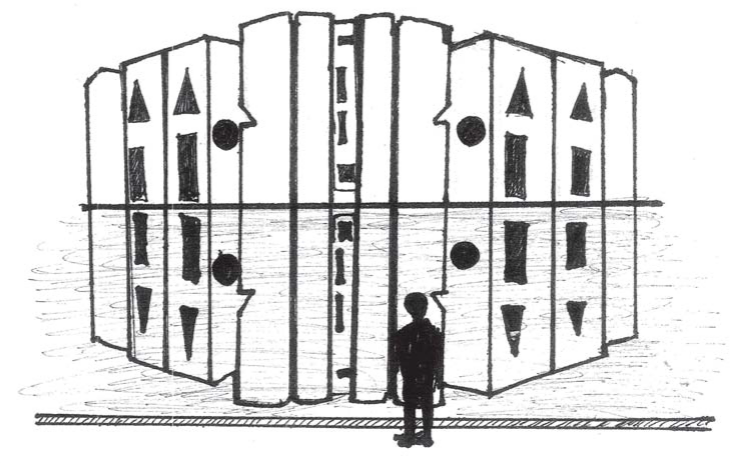
4.10. Time management
The design process does not end, but the deadline to submit ends. Being productive is all about efficiency as well as time management. It is not necessary to work hard, but to work smartly. When ȹ cannot manage time, they suffer from sleep deprivation and insomnia becomes a problem area. Excessive insomnia prevents proactive and positive thinking, leading to instantaneous responses so managing time and learning to work efficiently is important for ȹ.

4.11. Standing Upright
We experience the world with our bodies. Our body and architecture complement and define each other. We reside in architectural products, and architecture in turn resides in our bodies. While spending long hours in front of the computer drawing, we should notice our spine, and precautions should be taken against spine disorders triggered by posture disorder.
4.12. Digital Revolution
With the concepts of virtual design/online/cyber studio, remote collaboration design and web-based design, distance learning is becoming a part of daily life due to Covid-19 epidemic. Design critiques were given on the screen through images and sound. This revolution has replaced face-to-face interaction in urban gathering areas with digital social formations. Distance education has provided advantages such as flexibility in time and space, equality of opportunity, removal of borders, reduction of costs by being liberated from the building-classroom-studio-workshop-space, cheap and effective communication and rapid feedback. While the instructor has the role of mentor in the digital environment,ȹ learn by themselves, analyzing information and control the learning process.

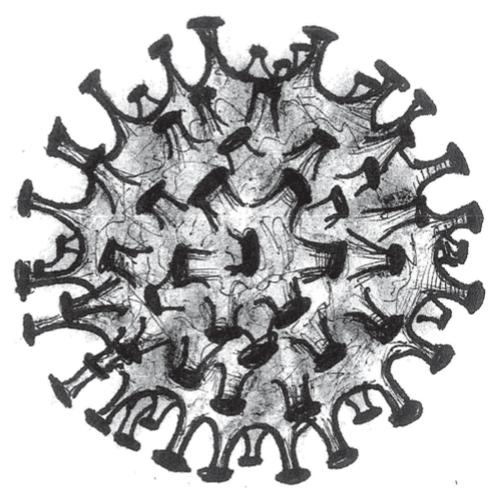
The codes of the virtual environment have also removed the borders. Distances have decreased. Academicians from different schools across Turkey and abroad and self-employed architects in the private sector have easily joined the studios. Although e-learning is not compatible with the nature of architectural education, it has been seen that it has the potential to support face-to-face education if effective communication is provided with the use of the right methods and technologies. ȹ should be ready for new developments to come with the digital revolution.
5. Conclusion
Architecture seeks to improve human life through buildings and cities. If values such as pleasure, humanism, creativity, usefulness, firmness and aesthetics cannot be offered to people, and if people do not encounter an aura that seduce their thoughts and bring their emotions and thoughts into contact with space, then there is no such thing as architecture there. Instead, there are forms and buildings. Architecture is not taught, but learned over time. When the basic and widespread problems which high school students coming from a predominantly multiple choice-based education system encounter in the field of architecture, which offers a predominantly visual communication education, and the ideas that could serve as solutions to those problems are presented through empathy two groups of suggestions can be made. The first group of suggestions that provide solutions to the problems faced by ȹ are about the mental transformation. The second group is behavioral and performative activities. ȹ, with a mindset for multiple-choice exam systems, should evolve into multiple and alternative thinking systems. It should be emphasized to the prospective architects during their undergraduate education that the school is not the place where ways are found, but rather where they are taught how to find them. Architecture is a biochemistry to establish a link between the shape, color, form, function, material, structure, detail and emotion. This biochemistry must have new learning dynamics in the face of the new world order and spaces brought about by the digital revolution. In order to be able to empathize with generation Z, it is crucial to learn thought patterns, behavioral forms, daily practices, the technology they use and even the language they have developed.
6. Further Research Question
Architecture evolves every day dealing with smart cities/homes, vertical cities, living affordable community, nomad micro homes, organic roof, immersive virtual reality, big data, Building Information Model, parametric architecture, 3D printer, internet of spaces, wearable technologies, chatbots, dialogue-based artificial intelligence software, robots, space age technologies. How should ȹ prepare for themselves when architecture is headed for a world where it may lose its function as a professional practice owing to artificial intelligence?
